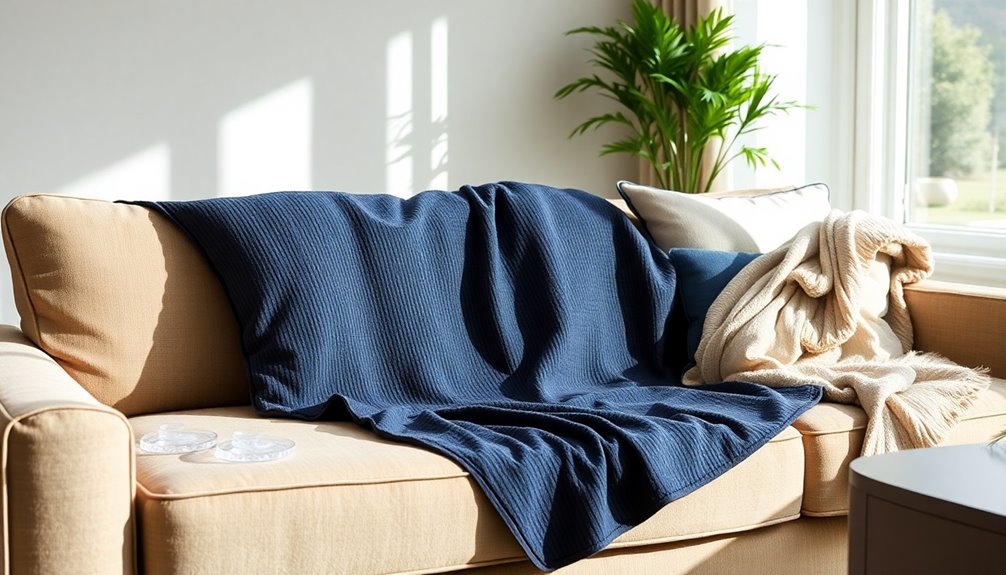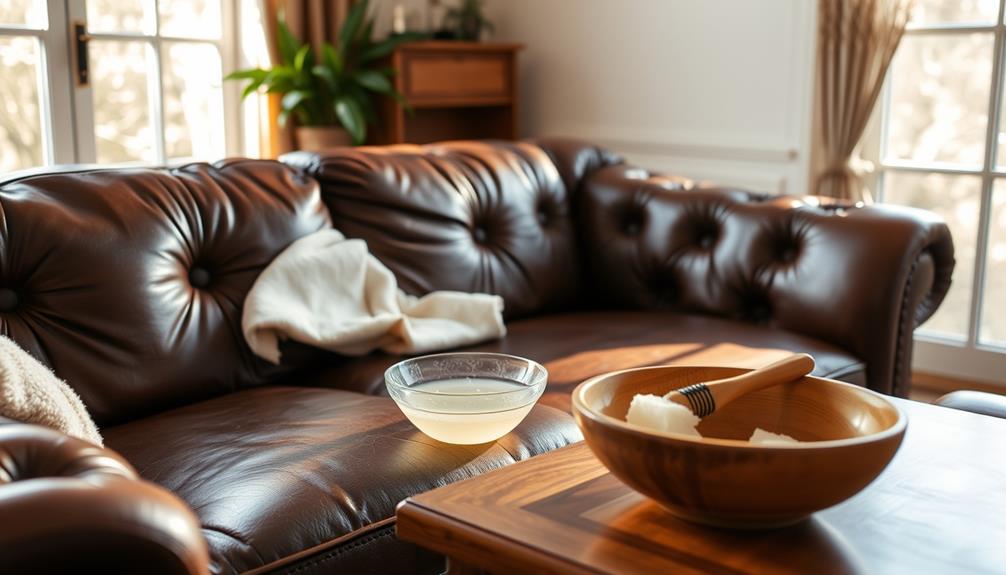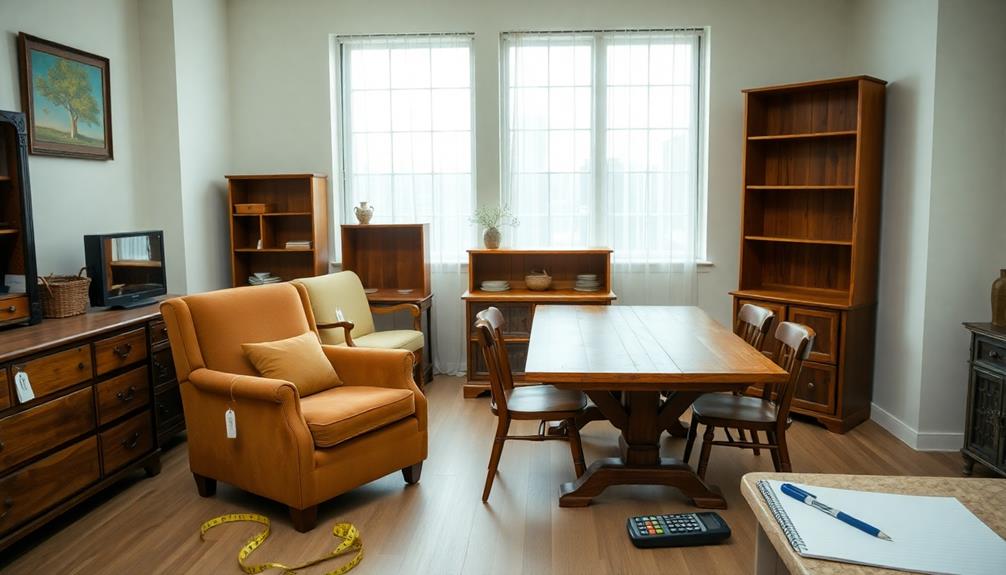To keep your sofa covers securely in place, start by investing in custom-fit covers that reduce excess fabric and slippage. Incorporate hidden elastic bands for a snug fit, and consider using cushion foam or pool noodles to fill creases and provide support. Regularly inspect and reinforce seams with heavy-duty thread to prevent fraying. Avoid direct sunlight to protect the fabric from fading. Additionally, properly store your covers when not in use to maintain their shape. These simple yet effective tips will ensure your sofa covers stay in place longer, and there are even more strategies to explore.
Key Takeaways
- Use custom-fit covers with hidden elastic bands to secure the fabric and minimize slippage.
- Incorporate cushion foam or pool noodles in creases for added support and stability.
- Regularly check and reinforce weak seams with double stitching or heavy-duty thread.
- Avoid excess fabric by choosing multi-piece designs that conform to your sofa's shape.
- Position your sofa away from direct sunlight to prevent fabric stretching and fading.
Introduction
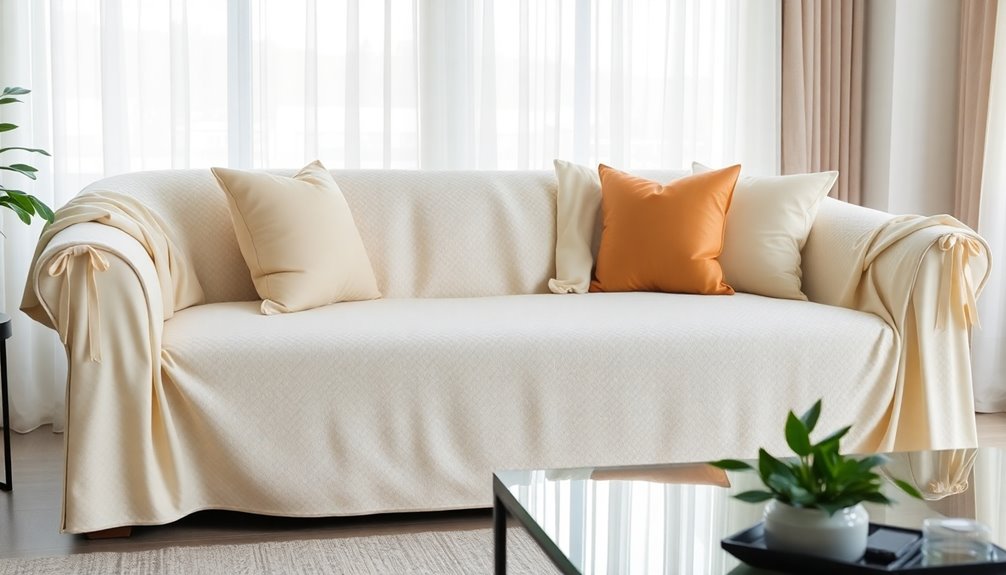
Keeping your sofa covers in place is just the beginning; routine spot cleaning is essential for maintaining their appearance. You'll want to use fabric-specific cleaning techniques to ensure your covers last longer and look great. Plus, knowing how to treat red wine spills can save you from a potential disaster, so let's get started!
Routine Spot Cleaning
Regularly spot cleaning your sofa covers is essential for maintaining their appearance and longevity. By addressing stains and spills promptly, you prevent them from setting, which helps preserve the quality of the fabric. Use a soft cloth and mild detergent to gently clean any affected areas, ensuring you follow up by rinsing with water to remove any residue.
If you have pets, it's even more crucial to act quickly. Addressing accidents right away minimizes odors and staining, extending the lifespan of your covers, which can withstand up to 10,000 washes. Additionally, using a lint roller or vacuum cleaner to remove pet hair and debris not only keeps your covers looking tidy but also enhances their adherence to the sofa.
Before applying any cleaning solution, always test it on a hidden area of the fabric. This precaution helps avoid damage or discoloration, thereby maintaining the overall quality of your covers. After spot cleaning, consider using a fabric protector spray to create a barrier against future stains and spills, further enhancing the durability and ease of maintenance for your sofa covers.
Fabric-Specific Cleaning Techniques
When it comes to cleaning your sofa covers, understanding the specific fabric type is crucial for effective maintenance. Different fabrics demand different cleaning methods, so always start by checking the care label. For instance, polyester can often be machine washed, while cotton may require gentle hand washing to prevent shrinkage.
Regular vacuuming is essential too, as it helps maintain the appearance of your covers by preventing dirt buildup that can lead to discoloration and wear. When tackling stubborn stains, use a mixture of mild detergent and water, applying it gently with a soft cloth. Avoid harsh chemicals that could damage the fibers of your fabric.
Before applying any cleaning solution, test it on a small, inconspicuous area first. This step ensures compatibility with the fabric and prevents any potential damage or discoloration. By following these fabric-specific cleaning techniques, you can prolong the life of your sofa covers and keep them looking fresh and inviting. Remember, a little care goes a long way in maintaining your furniture's beauty and comfort!
Treating Red Wine Spills
Spills are an inevitable part of life, and red wine is one of the trickiest stains to deal with on sofa covers. When a spill occurs, act quickly. Blot the stain immediately with a clean cloth to absorb excess liquid without rubbing it in further. This step is crucial to help prevent the fabric from absorbing the wine.
Next, mix one part white vinegar with two parts water and apply it to the stained area. Vinegar neutralizes the pigments in red wine, making it easier to remove. To absorb the remaining wine, sprinkle salt or baking soda on the damp stain and let it sit for several minutes before vacuuming it off.
For stubborn stains that don't budge, you can try a mixture of hydrogen peroxide and dish soap. Just make sure to test this solution on a hidden area of the cover first to ensure it won't damage the fabric. After treating the stain, launder the cover according to the care instructions. Most high-quality sofa covers can withstand up to 10,000 washes, ensuring they stay clean and beautiful for years to come.
Avoiding Direct Sunlight
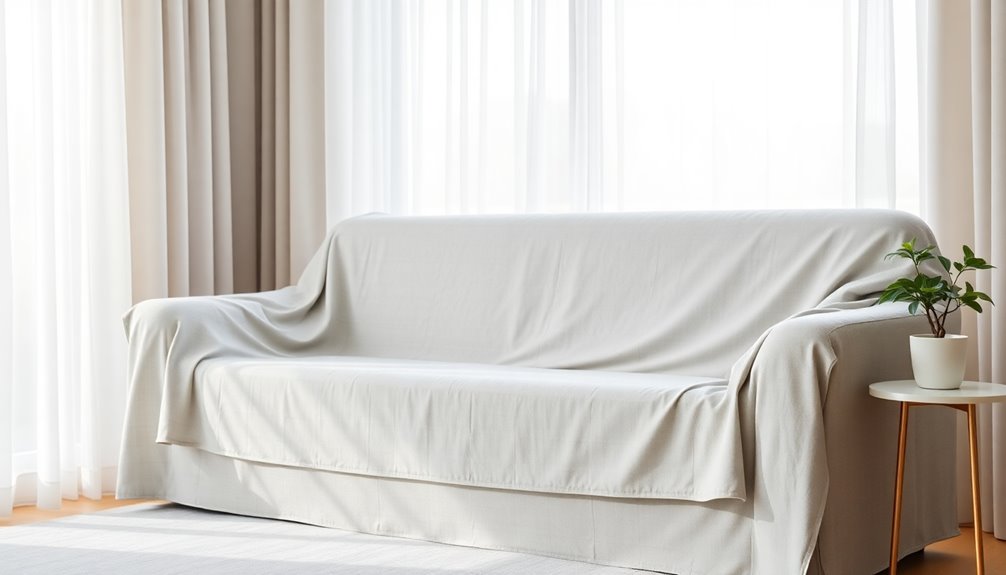
To keep your sofa covers looking fresh, avoiding direct sunlight is key. Consider pet-resistant fabric choices, as well as layering techniques to enhance stability. You might also want to apply fabric protectant sprays to shield against UV rays and prolong the life of your covers.
Pet-Resistant Fabric Choices
Choosing the right fabric for your sofa covers can make a significant difference in how well they withstand the wear and tear from pets. Opt for pet-resistant fabrics made from 95% polyester and 5% spandex; these materials offer durability while feeling soft to the touch. Heavyweight fabrics with non-slip properties can further enhance the stability of your slipcovers, ensuring they stay in place even during your pets' most active moments.
To maximize the longevity of your sofa covers, consider custom-fit options. A tailored fit not only minimizes slipping but also provides better protection against pet-related damage. Regularly washing your pet-resistant sofa covers is essential too, as they can endure up to 10,000 washes, keeping them fresh and free from pet hair and odors.
While choosing your fabrics, remember to avoid direct sunlight exposure. UV rays can degrade the quality of your covers and lead to unsightly fading. Position your sofas in shaded areas or use protective window treatments to keep your covers looking their best. With the right fabric choices and care, your sofa covers will remain resilient against your furry friends. Additionally, selecting heavier weight fabrics can help prevent slipping and enhance the stability of your slipcovers.
Layering for Added Stability
While selecting the right fabric is vital for durability, layering additional materials can significantly enhance the stability of your sofa covers. By placing a thin cotton sheet between the sofa cover and the sofa, you create extra friction that helps prevent slipping. This added layer makes a noticeable difference, especially if your slipcovers tend to slide around.
Another essential tip is to avoid direct sunlight on your sofa. Sunlight can lead to fading and deterioration of the fabric, compromising its grip and overall fit over time. To further improve stability, consider using non-slip pads or rug strips beneath the slipcovers. These tools enhance grip, particularly on smooth surfaces, ensuring your covers stay in place.
Regularly adjusting and tucking the cover after any sun exposure is also crucial. This maintenance keeps your slipcovers looking sharp and ensures they fit securely. By implementing these layering techniques and being mindful of sunlight, you can maintain the stability of your sofa covers, allowing you to enjoy your space without worrying about constant adjustments.
Using Fabric Protectant Sprays
When you want to keep your sofa covers looking fresh and durable, using fabric protectant sprays can be a game-changer. These sprays create a barrier against spills and stains, helping you maintain the integrity of your sofa covers and reducing the need for frequent cleaning. By applying the right fabric protectant, you can enhance the longevity of your covers, allowing them to withstand up to 10,000 washes without losing quality.
However, it's crucial to avoid direct sunlight when you use these sprays. UV rays can degrade both the protectant and the fabric, leading to fading and wear over time. To get the best results, ensure that the fabric protectant you choose is compatible with your cover material, ideally those containing a mix of 95% polyester and 5% spandex.
Don't forget to regularly reapply the protectant as recommended by the manufacturer. This practice is essential for maintaining its effectiveness and ensuring your sofa covers continue to look fresh and new. By following these tips, you'll not only protect your investment but also extend the life of your sofa covers.
Upholstery Seam Reinforcement Techniques
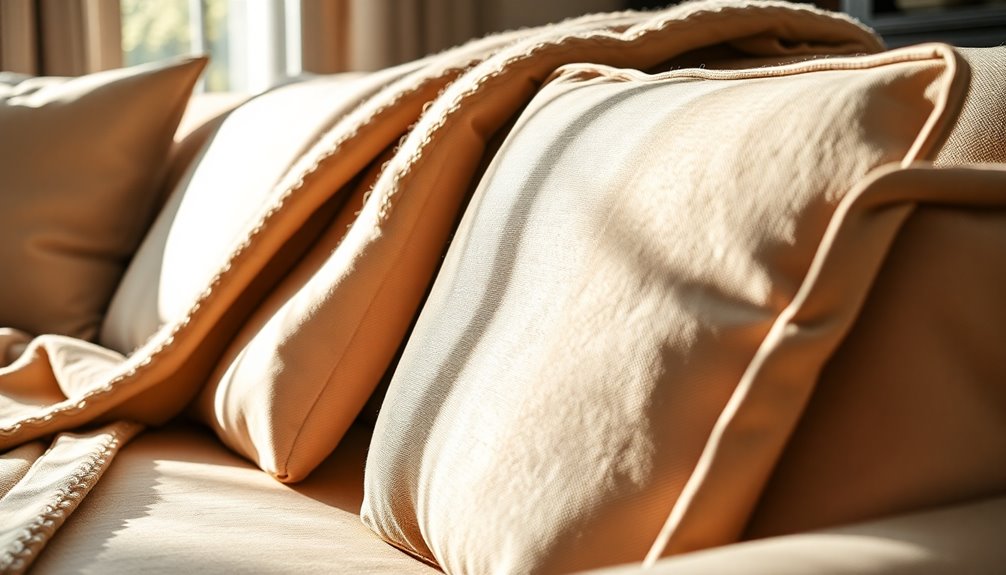
When it comes to upholstery seam reinforcement, addressing weak seams and stitching is crucial for maintaining your sofa cover's integrity. You'll also want to consider leather repair and conditioning to keep your materials in top shape. Plus, adding cushion foam for support can enhance comfort while ensuring your cover stays snug and secure.
Weak Seams and Stitching
To keep your sofa covers securely in place, tackling weak seams and stitching is essential. Weak seams can lead to fabric slipping and fraying, compromising the overall look and function of your covers. Start by reinforcing these seams using techniques like double stitching or employing a sewing machine with a zigzag stitch. This adds durability and improves the fit.
Consider using heavy-duty thread specifically designed for upholstery projects, as it offers greater strength and resistance to wear and tear. Adding seam tape or fusible interfacing to the interior of seams can also bolster weak areas, providing added support and minimizing fraying.
Don't forget to regularly inspect your seams for signs of wear. If you notice any weak points, promptly repair them with a needle and thread to maintain the integrity of your sofa cover and prevent slipping. In the meantime, using upholstery pins or clips along weakened seams can temporarily hold fabric in place until you apply a more permanent solution. By taking these steps, you'll ensure your sofa covers remain intact and looking great for years to come.
Leather Repair and Conditioning
While leather adds a touch of elegance to your furniture, maintaining its integrity through proper repair and conditioning is crucial. You should regularly inspect your upholstery seams for any signs of stress or damage. Timely leather repair can save you from costly fixes later on. Use specialized adhesives and patches to reinforce these seams, ensuring durability and longevity.
In high-use areas, consider employing techniques like double-stitching or seam tape to strengthen vulnerable spots. Conditioning treatments play a vital role as well. They enhance the flexibility and resilience of the leather, preventing cracks that could compromise seam integrity.
Additionally, applying a leather protector creates a barrier against spills and stains, which helps preserve the quality of both the seams and the overall upholstery. Make this a part of your routine care, and you'll notice a significant difference in the longevity of your leather furniture. By staying proactive with these practices, you can keep your sofa looking its best while enjoying the luxurious feel of leather for years to come. Regular maintenance is essential, as it can significantly improve indoor air quality and the overall comfort of your living space.
Cushion Foam for Support
Maintaining the integrity of your sofa covers goes beyond leather care; incorporating cushion foam can significantly enhance their stability. By filling the gaps between your sofa cushions and the covers, foam helps prevent slipping during use, ensuring your slipcovers stay in place.
Consider trimming foam sticks or even pool noodles to fit snugly into the creases of your sofa. This creates friction against the fabric, which effectively holds your cushion covers in position. High-quality foam materials are resilient, designed to withstand daily wear and tear, ensuring long-lasting support for your sofa covers.
You can easily customize foam inserts to match your sofa's specific dimensions, which reduces excess fabric and gives you a tailored fit. Regularly check the foam support for wear and replace it as needed; this simple maintenance task can significantly improve the overall appearance and functionality of your couch covers. Additionally, incorporating self-care practices into your routine can enhance your comfort while lounging on your sofa.
With the right use of cushion foam, you'll not only keep your slipcovers looking great but also enhance your overall comfort while lounging on your sofa. So, give it a try and enjoy the benefits of a well-supported, stylish living space!
Custom Fit Adjustments

A custom-fit sofa cover can transform your living space by providing a tailored look that stays in place. These covers are made to measure, ensuring a precise fit that hugs your sofa's contours perfectly. Accurate measurements are key; they help minimize excess fabric and enhance the overall appearance of your furniture.
One of the standout features of custom-fit sofa covers is the incorporation of hidden elastic bands. These bands anchor the fabric securely, preventing movement during use and significantly reducing slippage. You'll appreciate how well the cover adheres to your sofa, giving it a clean, polished look.
If you opt for a multi-piece design, you can enjoy even greater stability. Separate pieces for cushions and bases allow for a snug fit that conforms to your sofa's shape. This thoughtful design means you won't need to rely on additional securing methods, as these custom covers are built to stay in place. Investing in custom-fit sofa covers not only enhances your décor but also simplifies maintenance, ensuring your living space always looks its best.
Seasonal Storage Tips
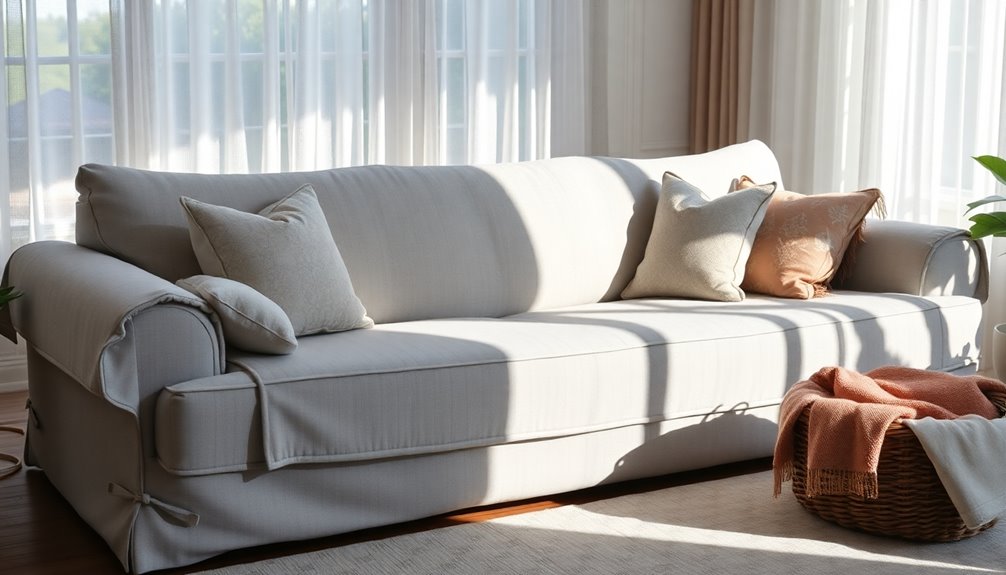
Your sofa covers deserve proper care during seasonal storage to ensure they stay fresh and in great condition. Start by making sure you keep your slipcovers clean and completely dry. This step is crucial to prevent mildew growth and any unpleasant odors. Once clean, fold your covers neatly, avoiding sharp creases that could become permanent. If you find it easier, consider rolling them for simpler handling when you're ready to reinstall.
Next, use breathable storage bags or containers to protect your covers from dust and pests while allowing for necessary air circulation. This helps maintain the fabric's integrity. It's also a good idea to label each bag with the type of cover and season, making retrieval quick and hassle-free when it's time to switch things up.
Lastly, store your covers in a cool, dry place away from direct sunlight. This prevents fading and fabric degradation over time. Following these seasonal storage tips will help ensure your sofa covers remain in excellent condition, ready to enhance your living space when the next season rolls around.
Conclusion
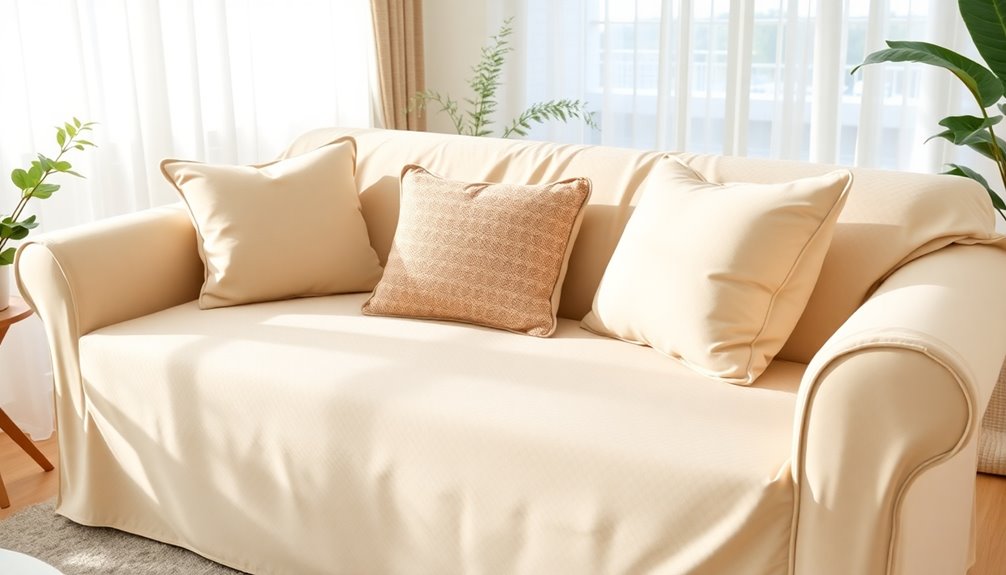
In conclusion, keeping sofa covers securely in place not only enhances the aesthetics of your living space but also prolongs the life of your furniture. By using effective methods like foam sticks or pool noodles, you can create friction that helps prevent slipping. Upholstery pins are another great option to secure loose sections of slipcovers without causing damage, especially in areas that see a lot of movement. For a more permanent solution, consider sewing Velcro strips into the edges of your covers and sofa; this creates a strong hold that minimizes shifting, particularly in high-traffic areas.
Don't forget that regular adjustments are necessary to maintain a snug fit. Simple techniques like tucking in excess fabric or using magazine rolls can help achieve a neat appearance. If you're looking for the best solution, custom-made slipcovers designed to fit your specific sofa dimensions will eliminate excess material and significantly reduce the likelihood of slippage. With these tips in mind, you can ensure your covers stay in place, adding beauty and durability to your furniture while keeping it looking fresh and new.
Frequently Asked Questions
How Do I Get My Couch Covers to Stay in Place?
To get your couch covers to stay in place, you can start by using foam sticks or pool noodles in the creases between cushions. This increases friction and helps prevent slipping. You can also use upholstery pins to secure loose areas, especially on the armrests. Velcro strips along the edges create a strong bond, while rolled magazines can fill gaps. Regularly check ties or straps to ensure a snug fit. Additionally, consider using a slipcover specifically designed for your couch model, as these often come with features that enhance grip and fit. For those looking for more advice on how to secure sofa cushion placement, you might also explore using weighted blankets to keep cushions anchored. Finally, rearranging your furniture can help minimize movement and maintain the overall aesthetic of your living space.
How Do I Keep My Sofa Cover From Moving?
To keep your sofa cover from moving, you'll want to enhance its grip. Tuck foam sticks or pool noodles into the creases for added friction. Use upholstery pins to secure the cover, especially on armrests. Velcro strips can provide a strong hold along the edges, while rug grip strips under the cover add stability. Don't forget to regularly check and tighten any ties or drawstrings to maintain a snug fit.
How to Keep Couch Cover From Falling Off?
To keep your couch cover from falling off, start by choosing a high-quality cover made from durable, heavyweight fabric. You can use foam sticks or pool noodles tucked between cushions to enhance stability. For extra security, consider upholstery pins that won't damage the fabric, and Velcro strips along the edges can create a strong hold. Don't forget to regularly check and adjust any ties or elastic bands for a snug fit.
How to Fix Sofa Cover From Slipping at Home?
To fix your sofa cover from slipping, try tucking foam sticks or trimmed pool noodles into the creases between the seat and back. This adds friction and helps keep the cover in place. You can also use small upholstery pins to secure loose sections without damaging the fabric. If you want a more permanent solution, consider using a staple gun on the corners or Velcro strips along the edges for a snug fit.
